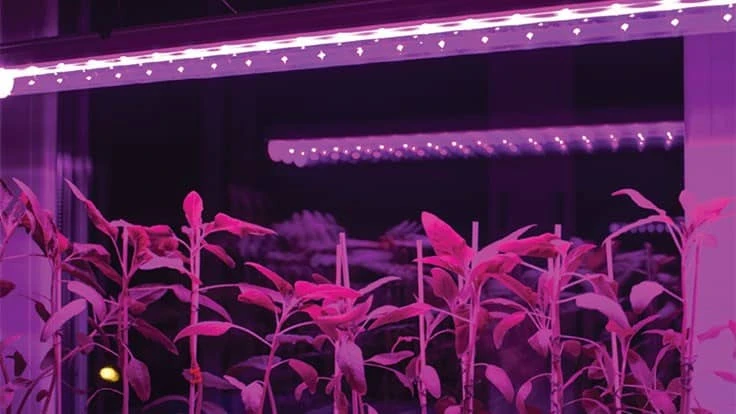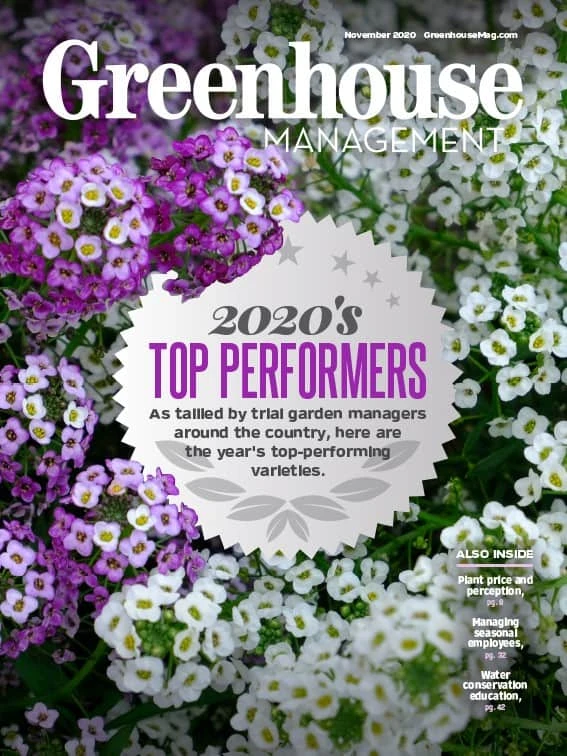

In early October, two days of online educational sessions and networking chats took the place of the annual Canadian Greenhouse Conference.
Two of the educational sessions centered around a topic that will only likely continue to grow in relevance: supplemental lighting.
As our 2020 Lighting Report grower survey uncovered recently here, more and more greenhouse operations are considering adding supplemental LEDs into the mix, as the technology has simultaneously become more affordable and better performing. More than two-thirds of respondents planned to upgrade supplemental lighting in the next three years, with the vast majority investing in LEDs.
“Compared to HPS fixtures, current LEDs are approaching 50% higher efficiency levels, they have much longer operating intervals, and many now offer the ability to dim the lights to adjust intensity, which is quite useful in Daily Light Integral control algorithms,” University of Guelph horticulture professor David Lewellyn told the virtual attendees. “This makes the LED fixture today a very powerful tool in the greenhouse.”
Twilight tips
Lwellyn addressed the conference on recent explorations he and his team at the University of Guelph have undertaken to understand the end-of-day lighting strategies in ornamental greenhouse production.
Commercial greenhouse growers increasingly are using what Lwellyn described as “targeted spectrum treatments using narrow band LEDs” to manipulate how plants sense and respond to different lighting environments.
“There is all sorts of spectral manipulation that can be done, especially at twilight and night time, using different spectral recipes, and you can even change lighting spectrums throughout the plant’s growth and vegetative cycles to cause specific effects,” the professor said.
Undertaking the research mostly in the university's controlled environment growth chambers — where the team could simulate and expertly dial in a wide range of environmental conditions — the trials focused on growing microgreens with different mixtures and spectrums of light.
“What we found is that, generally speaking, in microgreens blue light causes plants to stretch, and then if you mix blue and far red spectrums, they tend to stay more compact,” Lwellyn said. “In many cases you would see these same results in potted flowers and bedding plants.”
Focus on nighttime lighting strategies
Research undertaken in indoor fully controlled environments is useful for greenhouse operations to consider. But there will likely be varying results when applied to a commercial greenhouse environment, Lwellyn cautioned.
“Greenhouses offer much more variability in lighting conditions, both in (spectral) intensity and in quantity, and these variables will even vary throughout the day and with different weather conditions and seasons,” he said.
Shifting its focus to the greenhouse environment, the team predictably found that running supplemental LEDs during the day (on sunny days, specifically) in the greenhouse was impractical. The quantity and intensity of the sun’s natural rays is too intense for artificial lighting spectrums to overcome.
“What this means is, basically, to use different targeted spectrums in the greenhouse you need to focus your efforts on nighttime and twilight periods,” Lwellyn added.
Once the team had a grasp of this fact, they dug in even deeper, dividing each overnight lighting period into two separate halves, and applied different spectrum recipes over each half and measured plant response.
What Lwellyn’s team found is that nighttime spectrum treatments increased microgreen plant health substantially. Blue spectrums led to more compact plants than recipes using more far-red spectrum, but the blue spectrums appeared to have a greater positive impact on yield and overall plant quality.
“We think there are some commercial applications for using targeted spectral treatments to manipulate plant morphology, at least in vegetative plants,” the professor said. “But, what about flowering plants?”
“With chrysanthemum, which is a short-day period plant, the blue and plus red plus far-red spectrum recipe completely inhibited flowering in the greenhouse,” he added. “Under the majority blue treatment we did see flowering increase, which is a nice surprise. Calibrachoa, which is a long day period species, had better flowering growth under both nighttime spectral treatments that we applied [versus the control].”
Take home message
Lwellyn’s team concluded that the blue plus red plus far-red spectral recipe was the overall best choice for nighttime lighting in ornamental greenhouse production.
“Nighttime spectrum treatments, in some cases, increase plant quality without increasing flowering growth,” Lwellyn said in wrapping up his presentation. “Therefore, it stands to reason you could flower a short-day period plant over long days if you give it the right spectrum, and these spectrum recipe treatments might enable you to produce a better quality stock plant for rooted vegetative cuttings.”Effects of LEDs on insects
As more and more operations add in supplemental LEDs, researchers are hoping to learn what effects various spectrums of LED lighting have on biological control agents (BCAs), as well as unwanted pests.
Roselyne Labbe, a research scientist focused on greenhouse entomology studies within the Canadian government’s Agriculture and Agri-Food Canada agency, presented her latest findings on the topic during her aptly named “Like Moths to a Flame” presentation.
“We know artificial lights significantly improve crop production, but today there is little research into how these lights effect insects and flies and predatory mites,” Labbe stated. “We wanted to ask: How do light quality, quantity and DLI, affect insect populations and integrated pest management with BCAs?”
These trials, like the end-of-day lighting trials at the University of Guelph, were also undertaken in fully controlled environment research growth chambers. Conclusions have been made by the research team as to the application of what was learned to a commercial greenhouse environment.
“We learned that many, many insects do not have the photo receptor for red light spectrums, and we’re seeing that perhaps it is not necessarily the perception of light that is most important when it comes to insects, but rather the difference between this red spectrum and the others is the key,” she said.
On the topic of red spectrums, the team also found that plants receiving lots of red light also appeared to be beneficial to the organisms living on them. “We’re observing this possible interaction between the positive influence of red spectrum on the plant itself as well as the insect populations living on it,” she explained.
Blue light spectrums, conversely, showed some potential to harm some insect species by inducing diapause — which is a period of insect life cycle development where growth is inhibited by environmental factors. This effect, though, varied based on light intensity, according to Labbe.
“While we observed blue light having some negative impacts on our predator insects, shortening their lifespans, with lower intensity blue light there were some clear beneficial effects, but as we know, high intensity blue light can be toxic to all living things,” she said.
This led Labbe and her research team to query up yet another hypothesis: Does having too much artificial light in the greenhouse negatively effect BCA populations? You bet.
“Again, when applied at low intensity blue light can be beneficial, but longer duration and higher intensity can be bad [for insects],” she said. “There is mounting evidence that exposure to blue light spectrums can disrupt diapause and modulates a physical response in many arthropods.
“However,” she added in conclusion, “there remains much more research that is needed in commercial greenhouse environments for us to come to a clear conclusion on how BCAs and other insect populations are effected by artificial light.”

Explore the November 2020 Issue
Check out more from this issue and find your next story to read.
Latest from Greenhouse Management
- Anthura acquires Bromelia assets from Corn. Bak in Netherlands
- Top 10 stories for National Poinsettia Day
- Langendoen Mechanical hosts open house to showcase new greenhouse build
- Conor Foy joins EHR's national sales team
- Pantone announces its 2026 Color of the Year
- Syngenta granted federal registration for Trefinti nematicide/fungicide in ornamental market
- A legacy of influence
- HILA 2025 video highlights: John Gaydos of Proven Winners





